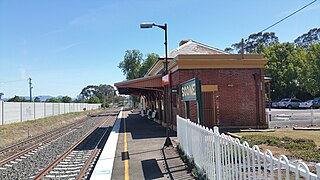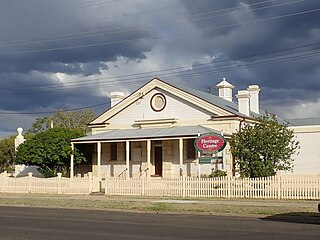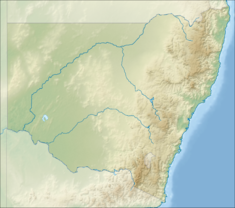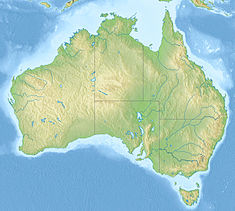
Scone is a town in the Upper Hunter Shire in the Hunter Region of New South Wales, Australia. At the 2021 census, Scone had a population of 5,013 people. It is on the New England Highway north of Muswellbrook about 270 kilometres north of Sydney, and is part of the New England (federal) and Upper Hunter (state) electorates. Scone is in a farming area and is also noted for breeding Thoroughbred racehorses. It is known as the "Horse capital of Australia".

The Upper Hunter Shire is a local government area in the Upper Hunter Valley of New South Wales, Australia. The Shire was formed in May 2004 from the Scone Shire and parts of Murrurundi and Merriwa shires.

The Warrumbungle Shire is a local government area in the central western region of New South Wales, Australia. The Shire is traversed by the Newell Highway. The Warrumbungle mountain range and Warrumbungles National Park are major tourist attractions for the Shire. Its seat is located in Coonabarabran, a town in the southwest.
John Verge (1782–1861) was an English architect, builder, pioneer settler in the Colony of New South Wales, who migrated to Australia and pursued his career there. Verge was one of the earliest and the most important architect of the Greek Revival in Australia. He also brought more comprehensive range of Regency style than any contemporary architects. His design indicates the increasing of sophistication compared to previous architect's design.

Scone railway station is a heritage-listed railway station located on the Main Northern line in Scone, in the Upper Hunter Shire local government area of New South Wales, Australia. The station serves the town of Scone and opened on 17 April 1871. The property was added to the New South Wales State Heritage Register on 2 April 1999.

Greta railway station is a heritage-listed railway station located on the Main Northern line in New South Wales, Australia. It serves the town of Greta, opening on 24 March 1862. It was added to the New South Wales State Heritage Register on 2 April 1999.
Courthouses in New South Wales were designed by the Colonial Architect, later known as the Government Architect of New South Wales, Australia.

Merriwa is a town located in the Upper Hunter Shire, in the far west of the Hunter region of New South Wales, Australia.

The Newcastle Civic Theatre, also known as The Civic, is a heritage-listed building located on Hunter Street, Newcastle, Australia. Opened in 1929, the 1520-seat theatre is now the venue for a wide range of musicals, plays, concerts and dance events each year and is the city's oldest surviving theatre.

Colonel Walter Liberty Vernon was an English architect who migrated to Australia and pursued his career as an architect in Sydney, New South Wales. In his role as the New South Wales Government Architect he is noted for designing multiple government buildings, many of which are extant with listings on national and state heritage registers.

Mortimer William Lewis was an English-born architect, surveyor and public servant who migrated to Australia and became Colonial Architect in the colony of New South Wales from 1835 to 1849. Lewis was responsible for designing and overseeing many government buildings in Sydney and rural New South Wales, many of which are heritage listed.

The Darlinghurst Courthouse is a heritage-listed courthouse building located adjacent to Taylor Square on Oxford Street in the inner city Sydney suburb of Darlinghurst in the City of Sydney local government area of New South Wales, Australia. Constructed in the Old Colonial Grecian style based on original designs by Colonial Architect, Mortimer Lewis, the building structure was completed in 1880 under the supervision of Lewis's successor, James Barnet. It was added to the New South Wales State Heritage Register on 2 April 1999.
St Barnabas Anglican Church is a heritage-listed former Anglican church located at Yarramalong Road, Yarramalong, in the Central Coast, New South Wales, Australia. It was built from 1889 by volunteer labour under supervision of James Bailey. The property is owned by the Central Coast Council. It was added to the New South Wales State Heritage Register on 2 April 1999.
Hargraves House, Noraville is a heritage-listed house at 3 Elizabeth Drive, Noraville in the Central Coast local government area of New South Wales, Australia. It was designed by Edward Hammond Hargraves and built from 1856 to 1859 by Mr Fletcher. It is also known as Hargraves House and Norahville. It was added to the New South Wales State Heritage Register on 2 April 1999.

The Corowa Courthouse is a heritage-listed courthouse located at 8 Church Street, Corowa, in the Riverina region of New South Wales, Australia. It was designed by James Barnet, the Colonial Architect, and built from 1886 to 1887 by W. Squires. It is also known as the Corowa Court House. The property is owned by the Department of Justice, an agency of the Government of New South Wales. It was added to the New South Wales State Heritage Register on 22 December 2000.

Clarence Town Courthouse is a heritage-listed former courthouse and now museum at 49 Grey Street, Clarence Town in the Hunter region of New South Wales, Australia. It was built from 1868 to 1869. It was added to the New South Wales State Heritage Register on 2 April 1999.

The Narrabri Gaol and Residence is a heritage-listed former gaol and now museum at Bowen Street, Narrabri, Narrabri Shire, New South Wales, Australia. The building was designed by James Barnet and built from 1880 to 1881 by J. Conlon. The property is owned by Narrabri Shire Council and was added to the New South Wales State Heritage Register on 2 April 1999.

Inverell Shire Council Building is a heritage-listed former bank and council chambers and now retail premises at 56 Byron Street, Inverell, Inverell Shire, New South Wales, Australia. It was added to the New South Wales State Heritage Register on 2 April 1999.

Milton Terrace is a heritage-listed series of terrace houses located at 1–19 Lower Fort Street, in the inner city Sydney suburb of Millers Point in the City of Sydney local government area of New South Wales, Australia. It was built from 1880 to 1882. The property was added to the New South Wales State Heritage Register on 2 April 1999.

Sydney Central Police Station, 7–9 Central Street, Sydney, New South Wales, Australia, is a police station with attached holding cells that operated in association with the Central Local Court House, Sydney, for nearly 100 years.


















